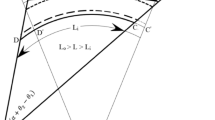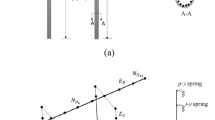Abstract
The seismic behavior of skewed bridges has not been well studied compared to straight bridges. Skewed bridges have shown extensive damage, especially due to deck rotation, shear keys failure, abutment unseating and column-bent drift. This research, therefore, aims to study the behavior of skewed and straight highway overpass bridges both with and without taking into account the effects of Soil-Structure Interaction (SSI) due to near-fault ground motions. Due to several sources of uncertainty associated with the ground motions, soil and structure, a probabilistic approach is needed. Thus, a probabilistic methodology similar to the one developed by the Pacific Earthquake Engineering Research Center (PEER) has been utilized to assess the probability of damage due to various levels of shaking using appropriate intensity measures with minimum dispersions. The probabilistic analyses were performed for various bridge configurations and site conditions, including sand ranging from loose to dense and clay ranging from soft to stiff, in order to evaluate the effects. The results proved a considerable susceptibility of skewed bridges to deck rotation and shear keys displacement. It was also found that SSI had a decreasing effect on the damage probability for various demands compared to the fixed-base model without including SSI. However, deck rotation for all types of the soil and also abutment unseating for very loose sand and soft clay showed an increase in damage probability compared to the fixed-base model. The damage probability for various demands has also been found to decrease with an increase of soil strength for both sandy and clayey sites. With respect to the variations in the skew angle, an increase in skew angle has had an increasing effect on the amplitude of the seismic response for various demands. Deck rotation has been very sensitive to the increase in the skew angle; therefore, as the skew angle increased, the deck rotation responded accordingly. Furthermore, abutment unseating showed an increasing trend due to an increase in skew angle for both fixed-base and SSI models.
Similar content being viewed by others
References
American Petroleum Institute (1993), Recommended Practice for Planning, Design and Constructing Fixed Offshore Platforms, API RP 2A — WSD, 20th ed., American Petroleum Institute.
Apirakvorapinit P, Mohammadi J and Shen J (2012), “Analytical Investigation of Potential Seismic Damage to a Skewed Bridge,” Practice Periodical on Structural Design and Construction, 17(1): 5–12.
Brandenberg SJ, Zhang J, Kashighandi P, Huo Y and Zhao M (2011), “Demand Fragility Surfaces for Bridges in Liquefied and Laterally Spreading Ground,” Rpt. No. PEER 2011/01, Pacific Earthquake Engineering Research Center, University of California, Berkeley, California.
Caltrans (2010), Caltrans Seismic Design Criteria Version 1.6, California Department of Transportation, Sacramento, CA.
Campbell KW and Bozorgnia Y (2008), “NGA Ground Motion Model for the Geometric Mean Horizontal Component of PGA, PGV, PGD and 5% Damped Linear Elastic Response Spectra for Periods Ranging from 0.01 to 10 s,” Earthquake Spectra, 24(1): 139–171.
Charney F (2010), “Site Classification Procedure for Seismic Design. SeismicLoads,” ASCE, 7(20): 11–18, doi: 10.1061/9780784410769, ch 03.
Chiou B, Darragh R, Grego N and Silva W (2008), “NGA Project Strong-motion Database,” Earthquake Spectra, 24(1): 23–44.
Dimitrakopoulos GD (2011), “Seismic Response Analysis of Skewed Bridges with Pounding Deck-Abutment Joints,” Engineering Structures, 33: 813–826.
Ghotbi A (2014), “Performance-based Seismic Assessment of Skewed Bridges with and without Considering Soil-structure Interaction Effects for Various Site Classes,” M.Sc Thesis, Long Beach, California: California State University, Long Beach.
Goel RK and Chopra AK (1997), “Evaluation of Bridge Abutment Capacityand Stiffness during Earthquakes,” Earthquake Spectra, 13(1): 1–24.
Jayaram N, Shahi S and Baker J (2010), “Ground Motion for PEER Transportation Research Program,” http://peer.berekeley.edu/transportation/gm-peer-transportation.html .
Kaviani P (2011), “Performance-based Seismic Assessment of Skewed Bridges,” PhD Dissertation, Irvine, California: University of California — Irvine.
Kaviani P, Zareian F and Taciroglu E (2012), “Seismic Behavior of Rein Forced Concrete Bridges with Skewangled Seat-type Abutments,” Engineering Structures, 45: 137–150.
Kawashima K, Unjoh S, Hoshikuma J and Kosa K (2010), “Damage of Transportation Facility due to 2010 Chile Earthquake,” Bridge Team Dispatched by Japan Society of Civil Engineers. http://peer.berkeley.edu/events/pdf/2010/Bridge-Damage-by-Chile-EQ-JSCE-Team.pdf .
Mackie KR, Lu J and Elgamal A (2012), “Performance-based Earthquake Assessment of Bridge Systems including Ground-foundation Interaction,” Soil Dynamics and Earthquake Engineering, 42: 184–196.
Mackie KR, Wong J and Stojadinovi B (2007), “Integrated Probabilistic Performance-based Evaluation of Benchmark Reinforced Concrete Bridges,” Technical Report 2007/09, Pacific Earthquake Engineering Research CenterEngineering Research Center, University of California, Berkeley, CA.
Maleki S (2005), “Seismic Modeling of Skewed Bridges with Elastomeric Bearings and Side Retainers,” Journal of Bridge Engineering, ASCE, 10(4): 442–449.
Matlock H (1970), “Correlations of Design of Laterally Loaded Piles in Soft Clay,” Proceedings, Offshore Technology Conference, Houston, TX, 1(1204): 577–594.
McKenna F, Fenves GL and Scott MH (2000), “Open System for Earthquake Engineering Simulation,” University of California Berkeley, California, Version 2.40.
Meng JY and Lui EM (2000), “Seismic Analysis and Assessment of a Skew Highway Bridge,” Engineering Structure, 22(11): 1433–1452.
Mohd Yassin M (1994), “Nonlinear Analysis of Prestressed Concrete structures under Monotonic and Cycling Loads,” PhD dissertation, University of California, Berkeley.
Nielson BG and DesRoches R (2007), “Seismic Fragility Methodology for Highway Bridges Using a Component Level Approach,” Earthquake Engineeringand Structural Dynamics, 36: 823–839.
Padgett JE and DesRoches R (2008), “Methodology for the Development of Analytical Fragility Curves for Retrofi tted Bridges Approach,” Earthquake Engineering and Structural Dynamics, 37: 1157–1174.
Padgett JE, Ghosha J and Dueñas-Osorioa L (2010), “Effects of Liquefi able Soil and Bridge Modelling Parameters on the Seismic Reliability of Critical Structural Components,” Structure and Infrastructure Engineering, 59–77, doi: 10.1080/15732479.2010.524654.
Qiang H, Xiuli D, Jingbo L, Zhongxian L, Liyun L and Jianfeng Z (2009), “Seismic Damage of Highway Bridges during the 2008 Wenchuan Earthquake,” Earthquake Engineering & Engineering Vibration, 8: 263–273.
Ramanathan K, DesRoches R and Padgett JE (2010), “Analytical Fragility Curves for Multispan Continuous Steel Girder Bridges in Moderate Seismic Zones,” Transportation Research Record: Journal of the Transportation Research Board, 2202: 173–182.
Rollins KM and Jessee SJ (2012), “Passive Force-Deflection Curves for Skewed Abutments,” Journal of Bridge Engineering, doi:10.1061/(ASCE)BE.1943- 5592.0000439.
Shamsabadi A and Nordal S (2006), “Modeling Passive Earth Pressures on Bridge Abutments for Nonlinear Seismic Soil-structure Interaction using Plaxis,” Plaxis Bulletin, 20: 8–15.
Shamsabadi A, Rollin KM and Kapuskar M (2007), “Nonlinear Soil-abutment-bridge Structure Interaction for Seismic Performance-based Design,” Journal of Geotechnical and Geoenvironmental Engineering, ASCE, 133(6): 707–720.
Shamsabadi A, Yan L and Martin G (2004), “Three Dimensional Nonlinear Seismic Soil-foundationstructure Interaction Analysis of a Skewed Bridge Considering Near Fault Effects,” USC Digital Library, http://ebookbrowse.com/gdoc.php?id=309799094&url=b512d2b24e7a704683837b470d5e7034 .
Shinozuka M, Feng MQ, Lee J and Naganuma T (2000), “Statistical Analysis of Fragility Curves,” Journal of Engineering Mechanics, ASCE, 126(12): 1224–1231.
Yashinsky M, Oviedo R, Ashford SA, Fargier-Gabaldon L and Hube M (2010), “Performance of Highway and Railway Structures During the February 27, 2010 Maule Chile Earthquake,” EERI/PEER/FHWA Bridge Team Report.
Zakeri B, Padgett JE and Ghodrati Amiri G (2013), “Fragility Analysis of Skewed Single Frame Concrete Box Girder Bridges,” Journal of Performance of Constructed Facilities, doi:10.1061/(ASCE)CF.1943- 5509.0000435.
Author information
Authors and Affiliations
Corresponding author
Rights and permissions
About this article
Cite this article
Ghotbi, A.R. Performance-based seismic assessment of skewed bridges with and without considering soil-foundation interaction effects for various site classes. Earthq. Eng. Eng. Vib. 13, 357–373 (2014). https://doi.org/10.1007/s11803-014-0248-7
Received:
Accepted:
Published:
Issue Date:
DOI: https://doi.org/10.1007/s11803-014-0248-7




